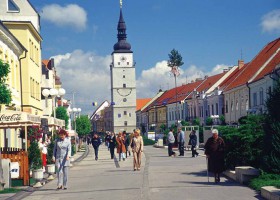Half-day Trips to Bratislava Environs
Overview
Modra – Červený Kameň Castle (5 hours)
Modra is a small wine-making town in the Lesser Carpathians, famous for its handmade ceramics. You should visit one of the small ceramics studios. Červený Kameň is a beautiful baroque castle in The Lesser Carpathians wich has the most extensive defensive system in Central Europe and a celebrated portrait gallery.
Modra – Červený kameň Castle + Wine-tasting (6 hours)
The Lesser Carpathians are well known for their large numbers of vineyards and the high quality wine they produce. You can sample the best of the Lesser Carpathian wines in one of the local wine cellars. The wine-tasting can also include visit to vineyards and wine production facilities (if the group wishes).
Special: Open Wine Cellars Weekend (annually in November) – a tour of many of the wine cellars, both large and small, in the Lesser Carpathians (price on request).
On request, a wine-tasting can be arranged in the Slovak National Collection of Wine (Chateau Pezinok), where you can find a selection of 80 different wines from all over Slovakia.
Trnava (4 hours)
Trnava is Slovakia's oldest town, the first to get a royal charter as a free borough. It is also known as the "Slovak Rome" for its many churches, all of which deserve a visit.
Traditional Goose / Duck Feast + Wine and Spirit Tasting
A visit to one of the famous “goose villages” on the outskitrts of Bratislava,where you can enjoy a delicious home-cooked meal,with good Slovak wines to wash it downand authentic Slovak spirit to aid the digestion.
Boat trip on the River Danube to the ruins of Devín Castle (5 hod)
This was an important castle, perched on a cliff above the confluence of the Danube and Morava Rivers. From this strategic position,the castle´s owner could control the rich flow of trade along the Danube, including a branch of the Amber Road linking the Baltic and the Mediterranean.
The area has been settled since the Neolithic period and was fortified in the Bronze and Iron Ages. Both, the Celts and the Romans built strong fortresses there. Later it was an important fortress of the Great Moravian Empire and then the Hungarian Kingdom, too. What we see today began as a gothic castle and underwent several reconstructions. In 1809, it was destroyed by Napoleon's soldiers and never fully restored.







